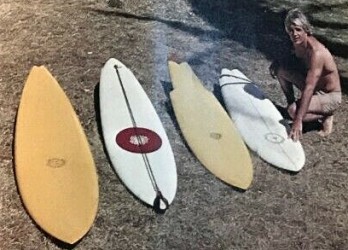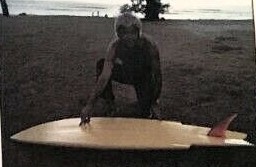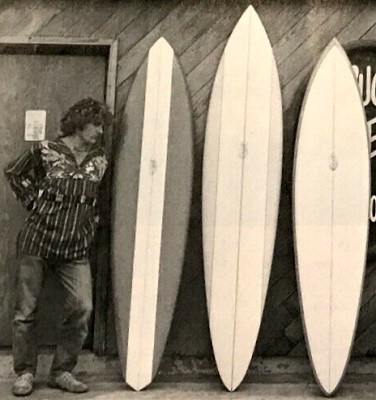
surfresearch.com.au
brewer - naughton : design, 1976.
brewer - naughton : design, 1976.
|
|
|
|
|
|
 |
surfresearch.com.au
brewer - naughton : design, 1976. |
| Dick Brewer : Hawaii Design |
Kevin Naughton : California Design |
| DICK
BREWER - HAWAII Dick Brewer's boards have transcended all the modern keystone areas of design philosophy. He is one of the few with the ability to combine all the combinations. 5'10" concave tail winger swallow 20" wide, 14 1/2" nose and tail, for waves of 2'-5'. The board in the picture was built 3 1/2 years ago and sent to Dick Catri in Florida. I bought the board back for $300 because I remembered liking it so well, having ridden it several times before it went back east. This 5'10" is almost identical to the one Purpus won the Malibu contest on three years ago, and Alden Kaikaka at Ala Moana (3A's) the same year using the same shape. It is just now become a popular design with most board builders, but slightly longer. |
 |
| The board is very
parallel in the tail section and middle because the
stings are so pronounced that they make the tail
virtually straight behind the stings. The board will climb vertically up and down the face sideways without a turning sensation, rather a weighting and un-weighting of the rail. It will do rotation turns on either sting, and is much faster than a normal surfboard going straight down the line, as it will pull into a completely parallel, to-the-face trim, whereas most boards will only trim with the nose pointed downhill. The fin is moved up on the sting, which also allows the board to pull into a tighter trim. I advocate fin boxes for stinger type boards, cause the fin must be moved up and down the board for different types of surf. Thoroughly
placed contours are the whole story
behind utilizing the laminar flow.
|
 Photos by
Steve Wilkins.
|
|
That's it.
Nothing else. I don't care what you hear from other parties. I say you can store it in your rafters, leave it on the beach overnight, keep it for years, hit it with a hammer, nothing can hurt the wave I just told you how to ride. Kevin Naughton - Bruce Jones Surfboards. Diamond tail: 7'2".
Gun: 8'.
Rounded-pin tail: 7'4".
N: 13 1/2", M: 20", T: 12". N: 12", M: 19 3/4", T: 10 3/4". N: 12 1/2", M: 19", T: 11 3/4". Kevin and Bruce Jones have surfed together at many of California's most eso-breaks over the last year or so, utilizing Bruce's specially outfitted boat. Dealing with such high quality, relatively uncrowded conditions can result in clean lines. Photo: Bruce
Jones.
|
 |
|
|
|
|
|
|